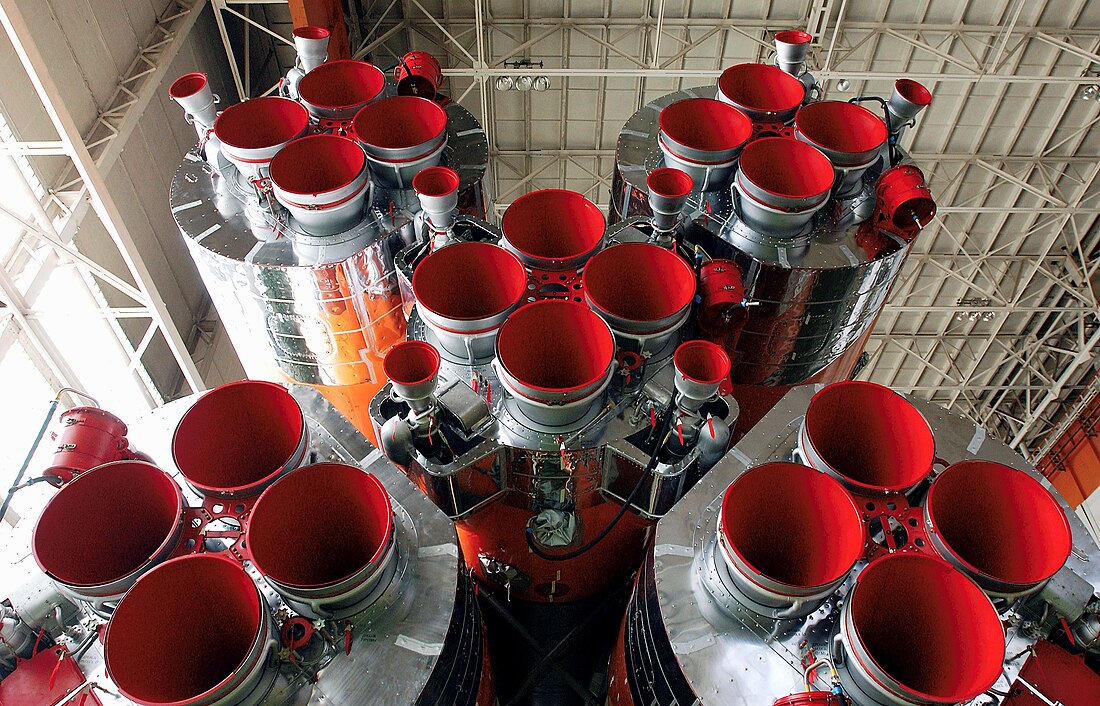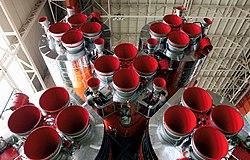热门问题
时间线
聊天
视角
RD-107
来自维基百科,自由的百科全书
Remove ads
RD-107(РД-107;索引8Д74)是一種火箭發動機,最初用於發射R-7弹道导弹,但後來用於造R-7系列火箭。用於聯盟號家族所有運載火箭第一級的每個側塊。截至2021年[update],非常相似的RD-107A和RD-108A引擎也用於發射現役聯盟2號運載火箭。[7]
Remove ads
設計

已隱藏部分未翻譯内容,歡迎參與翻譯。
The RD-107 was designed under the direction of Valentin Glushko at the Experimental Design Bureau (OKB-456) between 1954 and 1957. It uses liquid oxygen and kerosene as propellants operating in a gas generator cycle. As was typical by all the descendants of the V-2 rocket technology, the turbine is driven by steam generated by catalytic decomposition of H₂O₂. The steam generator uses solid F-30-P-G catalyst. These are based on a variable sized pellet covered in an aqueous solution of potassium permanganate and sodium. Each engine uses four fixed main combustion chambers. The RD-107 has an additional two vernier combustion chambers that can thrust vector in a single plane to supply attitude control. The RD-108 has four of such vernier combustion chambers to supply full vector control to the Blok-A stage. The single-axle turbopump unit includes the steam driven turbine, an oxidizer pump, a fuel pump, and a nitrogen gas generator for tank pressurization.[3]
The RD-107 engines are used in each of the boosters of the Soyuz-2 rocket, and a single RD-108 is used in the Blok-A stage (the central 1st stage).
One important innovation of this engine was the capability to use variable mixture ratio between fuel and oxidizer. The natural variations in manufacturing between each engine meant that without an active propellant consumption control, each boosters would deplete oxygen and fuel at different rates. This might result in as much as tens of tonnes of unburned propellant near the end of the burn. It would generate enormous strains on the structure and control authority due to the mass imbalance. Thus, the mixture ratio control system was developed to ensure the simultaneous consumption of propellant mass among the four R-7 boosters.[3][8]
生產
The RD-107 and RD-108 engines are produced at the JSC Kuznetsov plant in Samara, Russia, under the supervision of the Privolzhskiy branch of NPO Energomash, also known as the Volga branch.[1][3][5] The Privolzhsky branch was organized as a branch of OKB-456 in 1958, specifically for the manufacture of RD-107 and RD-108 engines. The branch was led by Y.D. Solovjev until 1960, then by R.I. Zelenev until 1975, then by A.F. Udalov until 1978, and is currently led by A.A. Ganin.[9]
自燃與煙火點火
Currently produced engines are ignited with a pyrotechnic ignition system. Energomash reports a new, hypergolic ignition system (on engines designated 14D21KhZ and 14D22KhZ) are ready for certification and flight tests.[5]
Remove ads
RD-107變體
已隱藏部分未翻譯内容,歡迎參與翻譯。
Modifications to the RD-107 design have led to production of several distinct versions of the engine:
- RD-107(索引8D74):原始版本。[4] Used on the R-7, Sputnik, Vostok and Voskhod.[3]
- RD-107K(索引8D74K):Improved version of the 8D74. Used on the Molniya (8К78).[3]
- RD-107ММ(索引8D728 or 8D74M):Increased thrust over the 8D74K by 5%.[4] Used on the Molniya-M (8К78М) and Soyuz (11A511).[3]
- RD-117(索引11D511):Improved structural changes.[4] Used on the Soyuz-U (11А511U) and Soyuz-U2 (11A511U2).[3]
- RD-107А(索引14D22):Improved version of the 11D511 with new injector design that eliminated the high frequency combustion instabilities.[4] Used on the Soyuz-FG (11А511U-FG), Soyuz-STA (372RN21A) and Soyuz-STB (372RN21B).[3]
- RD-107А(索引14D22KhZ):Chemical ignited version of the 14D22. Used on the Soyuz-2.1a (14A14-1A) and Soyuz-2.1b (14A14-1B).[3][10]
Remove ads
參考
外部鏈接
Wikiwand - on
Seamless Wikipedia browsing. On steroids.
Remove ads

